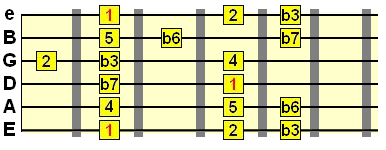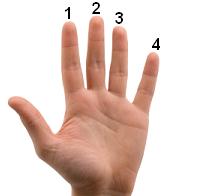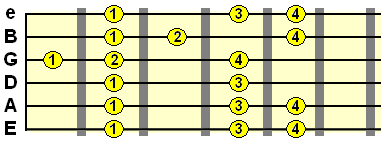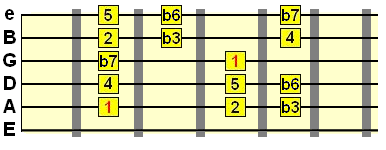Home
> Scales
> Natural
Minor Scale
Rather than just throw scale patterns at you (like many guitar sites out there) I'll provide you with some essential minor scale theory and backing tracks to help you explore this scale's unique flavour. You'll then be ready to apply the scale across the entire fretboard in a fluid and musical way.
Hear it (A Natural Minor)
First, let's look at the root position box pattern and analyse what makes up the natural minor scale.

The presence of the flat 3rd (♭3), also known as the minor 3rd, tells us it's a minor scale (ok, and the name "natural minor scale" is a bit of a giveaway!).
The minor triad is made up of the root (1), minor 3rd and 5th. The other tones in natural minor can be seen as "coloring", giving this particular minor scale its unique sound. We'll look at how these other tones interact with chords later.
 The most common
fingering for the above boxed pattern is as follows...
The most common
fingering for the above boxed pattern is as follows...

It's also useful to learn the boxed pattern for natural minor rooted on the A string, allowing you to play it conveniently around those A form minor barre/movable chords rooted on that same string...

We'll expand out of these boxes in another lesson. First, we need to understand a little theory behind the natural minor scale and how to use it over chords and chord progressions.
For example, take a listen to a typical minor key progression below that resolves around the tonic of E minor...
E minor - C major - D major - E minor - click to hear
In that example, E minor is clearly our tonic chord, so if we chose to play natural minor, we'd play the E natural minor scale.
A lot of knowing whether the other chords in the progression will "fit" with the scale will become clearer with time, as your ear develops. The chord sequences in the backing tracks we'll be playing over later will be compatible in this way.
Now, when resolving to that tonic minor chord, there is a tone you need to watch out for in natural minor...
The minor 6th (♭6)
The flat/minor 6th is most often used as a passing tone. These are tones you shouldn't emphasise as they will sound dissonant or too jarring on the tonic chord of a progression. Try to glance over them instead, as part of a larger phrase involving the other more stable tones from the scale (the most stable tones in the context of minor scales are those that make up the minor triad - the root, minor 3rd and 5th).
The lead section covers many techniques that will help negotiate passing tones effectively, but here's an example of how we might pass over the minor 6th in A natural minor...

Click to hear
So, make sure when you're learning a natural minor scale pattern that you learn where the minor 6th is situated (as well as the other tones!) so you can negotiate it properly over that root minor chord.
When the chord changes from the tonic minor chord, you'll have to use your best judgement as to which tones from the scale will be compatible. Again, over time your ear will get better at picking out chord movements that will correspond with phrases from the scale.
At this stage, the most important thing is you hear how each tone interacts with the chords, and especially the tonic minor chords of each sequence. Don't worry too much about elaborate lead guitar techniques at the moment - there's plenty of time to incorporate those! This lesson is all about hearing that "natural minor sound" in music.
As we're using the box patterns (provided for you again below), it's simply a case of positioning the 6th or 5th string root of the pattern at the right fret for the key you're playing in...


Natural Minor Scale Positions
Natural Minor Chord Progressions
Learn More Guitar Scales
Natural Minor Scale on Guitar
The natural minor scale (also the 6th mode of the major scale, Aeolian) is a very commonly used minor scale on guitar. There are a number of reasons for this, and it's therefore an important scale to understand. Free scale
pattern cheat sheet Free scale
pattern cheat sheetEssential scale patterns that every guitarist must know... Click here to start now |
Rather than just throw scale patterns at you (like many guitar sites out there) I'll provide you with some essential minor scale theory and backing tracks to help you explore this scale's unique flavour. You'll then be ready to apply the scale across the entire fretboard in a fluid and musical way.
Natural minor scale guitar basics
1
W
2 H ♭3 W 4
W
5 H ♭6
W ♭7 W 1
Hear it (A Natural Minor)
First, let's look at the root position box pattern and analyse what makes up the natural minor scale.

The presence of the flat 3rd (♭3), also known as the minor 3rd, tells us it's a minor scale (ok, and the name "natural minor scale" is a bit of a giveaway!).
The minor triad is made up of the root (1), minor 3rd and 5th. The other tones in natural minor can be seen as "coloring", giving this particular minor scale its unique sound. We'll look at how these other tones interact with chords later.
 The most common
fingering for the above boxed pattern is as follows...
The most common
fingering for the above boxed pattern is as follows...
It's also useful to learn the boxed pattern for natural minor rooted on the A string, allowing you to play it conveniently around those A form minor barre/movable chords rooted on that same string...

We'll expand out of these boxes in another lesson. First, we need to understand a little theory behind the natural minor scale and how to use it over chords and chord progressions.
Playing the natural minor scale over chords
As we established before, the natural minor scale is a... minor scale! Therefore it will be compatible with minor chords. However, it's often not that simple, as you'll be most likely playing over a sequence of chords, so you need to be able to identify natural minor chord progressions.For example, take a listen to a typical minor key progression below that resolves around the tonic of E minor...
E minor - C major - D major - E minor - click to hear
In that example, E minor is clearly our tonic chord, so if we chose to play natural minor, we'd play the E natural minor scale.
A lot of knowing whether the other chords in the progression will "fit" with the scale will become clearer with time, as your ear develops. The chord sequences in the backing tracks we'll be playing over later will be compatible in this way.
Now, when resolving to that tonic minor chord, there is a tone you need to watch out for in natural minor...
The minor 6th (♭6)
The flat/minor 6th is most often used as a passing tone. These are tones you shouldn't emphasise as they will sound dissonant or too jarring on the tonic chord of a progression. Try to glance over them instead, as part of a larger phrase involving the other more stable tones from the scale (the most stable tones in the context of minor scales are those that make up the minor triad - the root, minor 3rd and 5th).
The lead section covers many techniques that will help negotiate passing tones effectively, but here's an example of how we might pass over the minor 6th in A natural minor...

Click to hear
So, make sure when you're learning a natural minor scale pattern that you learn where the minor 6th is situated (as well as the other tones!) so you can negotiate it properly over that root minor chord.
When the chord changes from the tonic minor chord, you'll have to use your best judgement as to which tones from the scale will be compatible. Again, over time your ear will get better at picking out chord movements that will correspond with phrases from the scale.
Natural minor scale backing tracks
So, from what we've learned - the basic boxed patterns and using the flat 6th as a passing tone, have an experiment with natural minor over the backing tracks below. They are written specifically for this scale and use chord sequences that reside firmly within the key of A minor and F# minor respectively. One easy going, the other more rock/metal! There's also a drone track, which is just a minor chord with no changes, to help you explore the scale over a single chord.At this stage, the most important thing is you hear how each tone interacts with the chords, and especially the tonic minor chords of each sequence. Don't worry too much about elaborate lead guitar techniques at the moment - there's plenty of time to incorporate those! This lesson is all about hearing that "natural minor sound" in music.
As we're using the box patterns (provided for you again below), it's simply a case of positioning the 6th or 5th string root of the pattern at the right fret for the key you're playing in...
| Key | E string root note | A string root note | Download |
| B minor (B natural minor) |
Fret 7 Fret 19 |
Fret 2 Fret 14 |
Right click "save as" |
| A minor (A natural minor) |
Fret 5 Fret 17 |
Fret 12 | Right click "save as" |
| F# minor (F# natural minor) |
Fret
2 Fret 14 |
Fret
9 |
Right click "save as" |


| |
Tweet |
Stay updated and learn more
Sign up to the newsletter for updates and grab your free Uncommon Chords book
Sign up to the newsletter for updates and grab your free Uncommon Chords book
Related
Natural Minor Scale Positions
Natural Minor Chord Progressions
Learn More Guitar Scales








